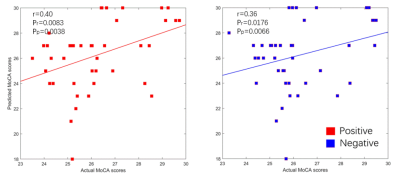An ping Shi1 and Xi yang Tang2
1Department of Radiology & Functional and Molecular Imaging Key Lab of Shaanxi Province, Department of Radiology & Functional and Molecular Imaging Key Lab of Shaanxi Province, Tangdu Hospital, Fourth Military Medical University (Air Force Medical University), Xi'an, Shaanxi, China, 2Department of thoracic surgery, Tangdu Hospital, Air Force Medical University., Xi'an, China
1Department of Radiology & Functional and Molecular Imaging Key Lab of Shaanxi Province, Department of Radiology & Functional and Molecular Imaging Key Lab of Shaanxi Province, Tangdu Hospital, Fourth Military Medical University (Air Force Medical University), Xi'an, Shaanxi, China, 2Department of thoracic surgery, Tangdu Hospital, Air Force Medical University., Xi'an, China
We find that, the identified
connectome-based predictive model, based on whole-brain RSFC patterns, are
strong for predicting the MoCA scores in T2DM. The application of CPM to predict
neurocognitive abilities can bring significant clinical benefits to patient
management.

Figure 1. CPM predicts the MoCA scores from
T2DM. Scatterplot of predicted MoCA scores vs actual MoCA scores. Predicted
scores were generated using edges positively correlated with prediction
(positive network) and negatively correlated with prediction (negative network).
r, r value of Pearson's correlation between predicted MoCA scores and actual MoCA
scores. Pr, P values of Pearson's correlation between predicted MoCA scores and
actual MoCA scores. Pp: p values obtained from
permutation tests (5000 times).